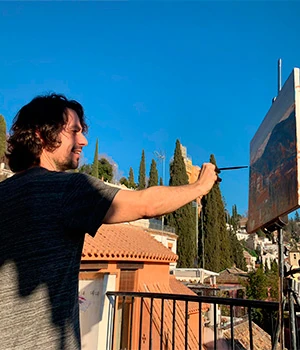
BIO
Born in Almería, 1974.
BA in Fine Arts, University of Granada (1993 – 1998).
His first exhibition focus on Almeria’s and Granada’s landscape: ‘Desde lo alto, desde el suelo’ (Galería Jesús Puerta, 2000), and ‘Tierra y Mar’ (Galería de arte Mojácar, 2001). From then on, he inspired in Sierra Nevada’s range summits thus showing his painting in several exhibitions, being the most remarkable ‘Pinturas de Sierra Nevada’ (Galería Clave, Murcia) and ‘Paisajes de Sierra Nevada’ (Centro Cultural Gran Capitán, Granada, 2003).
In 2006, he started a series of travels, thus visiting places like Paris, Berlin, London, Rome, Venice, Florence, Tuscany, New York, The Andes and Syria. He joined collective exhibitions and individual exhibitions focusing on artworks inspired by those places. Even though he works on diverse genres between 2010 and 2014, the landscape remains a paramount subject amongst his projects, including a series of artworks on Granada’s meadows in which tobacco drying barns and farms are the main subjects of his drawings and paintings.
ARTWORK
Carreño’s mountain landscape painting is part of a long tradition in which summits have been a chief subject to many artists and travellers along the 19th and early 20th centuries. Albeit since the mountain range’s summits ceased to be unexplored, menacing territories thus allowing a more ludic approach. Henceforth, mountain peaks, glaciers and waterfalls become appreciated subjects together with the experimentation of the light effects such as light’s reverberation on snow. Sierra Nevada has been a major focus of interest in painting during the last two centuries, usually as a background for Granada’s cityscape, for landscapes painted within the range are scarce.
Carreño has been researching and experimenting with landscape genre for years, but no environment has captivated him in such an obsessive manner as Sierra Nevada. He has painted many sketches and paintings, in which he delves into the connection between the city, the ‘Vega’ and the mountain.
His approach resembles that of Cezanne’s ‘Sainte-Victoire’ mountain series, which the French master painted at least 87 times first from far but closer afterwards, and from different angles. He ceaselessly observed the mountain for hours through all the seasons, so he knew it by memory. The more he observed it, the more ability he had to resume it, providing order and clarity to the nature’s environment, thus breaking with academicism and proposing new solutions.
Carrreño’s approach, however, shows the mountain landscape genre strength from within the range. He thus shows his particular approach, as well as the development of his own style sustained by years of reflection on the meaning of painting and in the oil on canvas sketch exercise as a routine that enables to discipline the sight. He sketches the natural by using oil in an urgent, hastily manner, to capture the range’s light and colour essence. This enabled him to experimenting with the painterly matter density, and with the tones of the subject.
It is also necessary to consider his long years of study and deep reflection on Sierra Nevada’s image, through years walking her summits, synthetised in his studio paintings. In these, is is possible to appreciate an apparently risky use of colour and an exceptional light depiction. It is also noticeable the paint’s density and impasto, to masterly depict the material’s textures in the fore. This skill alternates with subtle veilings overlapped in different layers to transform the initial colour’s transformation.
On Carreño’s use of colour in his paintings, Manuel Titos Martinez states in the “Paisajes de Sierra Nevada. Francisco Carreño” exhibition catalogue:
‘We know snow is white. But snow has so many different whites! So many singular forms acquire in the snowfields! The soil is rough, vertical and stony. But, so many different greys, violets, greens and blacks it contains! Sky is blue and plane. But, how many different blues offer the daytime! Lakes are water plates. But is it blue? Green? Grey? Black? Melting snow, rocks, lakes, the trails that go further towards a remote depth, they offer a range of forms and nuances that seems to lead us to a landscape imaginary rather than real. When an experienced observer may conclude that the painter has invented nothing, but simply applied eyes and hands to show us something that is there. It is simply matter of going to stare at it and knowing how to see it. See, also, at different times, days and seasons with that cyclic character that nature has, and that acquires a rupturing strength in the mountain. Not only through light or colour, but also through form itself, different whether it is dominated or conformed by ice or rock.
Carreño’s painting follows the legacy of painters like Constable, Turner, Freidrich, Caspar Wolf, Dahl, Carlos de Haes, Beruete or Sorolla. Likewise, he provides a new approach to Sierra Nevada’s depiction far from the Romantic landscape concept except for what concerns to the painter’s subjectivity or the mountain’s majesty and roughness and the studio compositive academicism traces in the work. Many of his paintings dhow a rough landscape, almost deprived of snow as they look during the summer, and lacking human figure. It is the spectator thar needs to face the mountain’s solitude and void when contemplating his paintings.


